
“H
ey, Ching-Chong. Bus fee.”
The driver’s words slapped me across the face. I handed him some money and waited for my change. Everyone on the bus was silent, watching. “Here you go, Chong-Chong,” he quipped while handing me a coin in return. My face turned red.
“Please don’t call me that. I really don’t appreciate it.” I felt my voice quivering but hoped that it sounded steady.
He laughed. “Okay, darling. What’s your name?”
“I’m Hannah.”
“Okay, Hannah.” He walked around the bus to collect the other passengers’ fares and muttered something in Kweyol, the local dialect. A few people chuckled. Then he climbed into the driver’s seat and we took off on the winding road toward my village. I put my headphones on and tried to calm my pounding heart.
I am a Peace Corps volunteer in St. Lucia, a small Caribbean island country north of Venezuela. Not many Americans know much about the island beyond the fact that the season finale of ABC’s The Bachelor was filmed at a resort here a couple years ago. Likewise, not many locals from my community know much about America aside from what they’ve seen on television.
One of the stated goals of the Peace Corps is to fill these sorts of gaps in cultural awareness. As volunteers, we explain what it means to be American to the people we meet here, and we share our experiences abroad with those back home. Instead of trading goods, we are trading cultures.
I teach English to schoolchildren in Canaries, a rural fishing village with a population under 2,000. It is one of St. Lucia’s poorest and most underdeveloped areas. Although luxurious hotels and resorts dot the island, jobs within tourism remain largely inaccessible to the people in my community. There are no attractions, restaurants, or gas stations in Canaries, so even when visitors do drive by they have no reason to stop.
Cut off from the tourist world, most villagers have never been exposed to the idea that America is ethnically diverse. Canaries has had Peace Corps volunteers in the past, but as far as anyone can remember, all of them have been white. As a result, confusion about me—the first Chinese American to live in the community—has been inevitable.
There was a teenage girl, fourteen or so years old, who approached me urgently as I walked to an evening aerobics class. “Miss, I just have to ask,” she said. “Are you from China or Japan?”
“I’m actually from America, but my family is from China.”
She said, “Oh,” and ran on.
There was an older man who gave me a ride to the grocery store and told me he was “also” a Buddhist. “If you don’t believe me, I have Buddha statues all over my home. Want to stop by to see?”
“No thank you, I’m actually not Buddhist.”
There was an elderly lady on the bus who mistook me for a member of a Japanese volunteer group visiting the island. “You did such a lovely job at the choir performance last weekend!”
I thanked her for the compliment.
In my application to join the Peace Corps, I wrote that one of the challenges I expected to face during my time abroad was having to answer the question, “If you’re from America, how come you look Chinese?” The possibility hadn’t discouraged me, though. In fact, before I left for St. Lucia, I was excited about sharing what I knew about America’s racial diversity with the locals I would meet. I assumed they would be open-minded and just as interested in American culture as I was in theirs.
Getting called “Ching-Chong” made me think I had been too idealistic.

One day, I was riding in a large food-supplier truck heading to Castries, the island’s capital, where I had a meeting scheduled that afternoon. It was a forty-five minute drive to town, and to pass the time I chatted with the two men in the truck. They soon discovered that I was a Peace Corps volunteer from the States. Kenny and Shem had heard of the Peace Corps before, but they weren’t at all interested in learning about anything related to America. They wanted Mandarin lessons.
“Teach us some bad words in Chinese!” they prodded me. Kenny, a friendly man with cornrows, took out a pen and paper to jot down the phrases phonetically. “We’re going to say these to our boss next time he makes us angry!”
“Is your boss Chinese?” I asked, nervous that this would eventually be traced back to me.
“Nope. He’s Lucian. He won’t have any idea what we’re saying!”
When we reached Castries, I got out of the truck and waved goodbye. After Kenny and Shem drove off, I found myself thinking about our conversation. Thanks to me, the two of them had learned enough Mandarin phrases to get themselves fired. But they hadn’t learned anything about America, the country I was supposed to be representing. I began to realize that even though I’m here in St. Lucia to exchange cultures, I don’t necessarily get to decide which culture I exchange. Kenny and Shem had heard my story about being Chinese American, yet Chinese culture was what they had insisted on trading with me.
Perhaps this wasn’t a bad thing. Recently a local friend asked me, “You don’t know karate, do you?”
I told him no, not at all.
“Well, you know, people here watch a lot of kung fu movies and that’s the main thing they know about Chinese people. They probably all assume you know karate.” He paused. I wasn’t sure how to fill the silence. “You should let them think that,” he continued. “It might keep you safe here because nobody’s going to want to harm you.”
I smiled. His words were unexpectedly reassuring. Maybe, I thought, it was okay to leave the choice in their hands.

One of my favorite things about St. Lucians is their love of sharing food—something they have in common with the Chinese, as my own family’s experiences have taught me. For people here, sharing food establishes trust and a sense of community. My school principal will buy fish from our village, clean it, cook it with local seasoning, and give it to me in a Tupperware container to take home. A teacher will surreptitiously hand me mangos in the middle of class while the children are doing their work, whispering, “These are from our tree.” Students will come to school with a small bag of love apples, present one to me and say, “Teacher Hannah, look.” “For me?” “For you.”
The first time I brought food for the school staff, I chose something quintessentially American: toasted blueberry bagels with Philadelphia cream cheese. None of them had ever eaten bagels before, and they all wanted seconds to take home. At the end of the school year (some trays of brownies and Christmas sugar cookies later), I decided to share something completely different: mantou, a steamed bun that my grandfather would make for us every time our family visited him in China.
I remembered how he would spend all day making the mantou. Carefully mixing the flour with water, yeast, and a little bit of sugar. Kneading the dough meticulously with his hands. Rolling, cutting, and forming it into the bun-shape so familiar to us. We would eat his mantou every day for breakfast until the batch was gone, and then he would happily make more.
I told the teachers that the mantou was Chinese bread that they could either eat plain or with any kind of butter, jam, or sauce. They were amazed that the bread didn’t need to bake in the oven, and that it was so powdery white, without a trace of brown. They loved it. Most of them ate it with local cheese.
Though none of them knew it, bringing my grandfather’s mantou to my school was an important moment for me. It was the first time I chose to share my Chinese culture with the people here. This time, they hadn’t needed to prompt me with their questions. This time, I hadn’t agonized over whether I, their cultural ambassador from America, was exchanging something “un-American.”

I was two years old when my parents and I immigrated to the States. Growing up, I felt as if we were all learning what it meant to be American together. The ways of my parents were often at odds with the ways of my classmates’ parents. My classmates went to church on Sundays; I went to Chinese language school to learn Mandarin. My classmates brought PB&J sandwiches for lunch; I brought rice and vegetables, with a pair of chopsticks. My classmates had turkey, stuffing, and pie for Thanksgiving; I had Chinese hot pot.
As my brothers and I got older, our family started traveling to China during the summers to visit relatives. For Mom and Dad, these trips were like going home. Everything in China was familiar to them. I could tell that a sense of peace washed over them when we were there—they became less anxious, laughed more easily, and seemed to know everything intuitively. For me, though, these trips were the opposite of peaceful. They made me feel even more displaced, even more conscious of the fact that as a Chinese American, neither culture was truly mine.
When I started living on my own, I decided that being in this sort of limbo wasn’t healthy—I needed to commit to one culture. Because I felt that Chinese culture had isolated me from my peers when I was younger, as soon as I had the choice to turn away from it, I did. Aside from the occasional Mandarin conversation with a cab driver, late-night order of Chinese takeout, or short trip to visit my family, nothing about my adult life was culturally Chinese. The lunches I brought to work, the holidays I celebrated, the movies, books, and music I consumed—all of it was American.
By the time I arrived in St. Lucia, I had developed a tense, almost in-denial relationship with my Chinese heritage. I had put so much effort into belonging to something else that when people here reminded me of my ethnicity—when they asked about Chinese culture and insisted on exchanging it with me—I felt like they were challenging my fundamental sense of self.
Sharing my grandfather’s mantou was the moment I made peace with my identity. I realized that my culture isn’t confined to a particular country—not America, not China. It’s the blend of values, customs, and traditions that I’ve absorbed throughout my life, from all of my surroundings.
For other volunteers—those who conform to what people in more remote parts of the world imagine Americans to look and behave like—maybe the act of cultural exchange is straightforward. But for me, it cannot happen so simply. And just because my experience is different, I’ve learned, doesn’t mean that it’s wrong.
The bus driver and I have never spoken about our “Ching-Chong” encounter, and we probably never will. But I still ride his bus all the time. He knows the exact curve of the hill where I call out, “Stopping, please,” and will drop me right in front of my house. On my way home the other day, he glanced up at me in the rearview mirror before that turn in the road, and I nodded at him. Without my saying a word, he pulled over. “Thank you,” I said to him as I climbed out. “Take care, darling,” he said back.
Hannah Jiang is currently a Peace Corps volunteer in St. Lucia, where she teaches at a school and contributes to the national news station. A Yale graduate, she previously worked in Manhattan for an executive search firm.
- Follow us on Twitter: @inthefray
- Comment on stories or like us on Facebook
- Subscribe to our free email newsletter
- Send us your writing, photography, or artwork
- Republish our Creative Commons-licensed content

